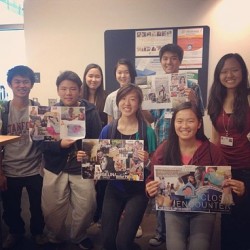This summer we’re sponsoring high school interns in stem cell labs throughout California. We asked those students to contribute to our Instagram photos and YouTube videos about life in the lab, and write about their experiences.
Christina Ren is a junior at Monte Vista High School in Danville, California. She works in the lab of Dr. Ching-Cheng Chen in the Department of Stem Cell and Leukemia. Her current project at the City of Hope aims to study the impact of leukemia cells and leukemia-derived exosomes on stroma cell differentiation and its chemoprotective effect on leukemia cells. In addition to my interest in science research, she also founded a science community service mentoring program called Science Alliance Network which aims to help foster school clubs to pair elementary and middle school “buddies” with high school mentors to help these buddies on their science fair project. Christina also enjoys extracurricular activities, such as ballet, Chinese classical dance, flute, and swimming.
 |
| The City of Hope high school summer interns submitted this photo to our #CIRMStemCellLab Instagram feed. |
Every day during my walk over to the cafeteria at the City of Hope, I witness my inspiration: a small patient room protruding from the elegant glass buildings of the Helford Hospital. Through the windows, I see a collage of photos plastered on the opposite wall, covering the entire surface of the pinboard like a monolayer of cells on a petri dish. Sometimes I stop and squint to see if I can make out the individual photos; they are all of people. Some are of patients out abroad traveling to scenic places, some of nurses and their fellow coworkers. There are also frequently patients in there, hooked up to expensive-looking machinery. One elderly woman wearing a soft, floral lavender headscarf was reading The Fault of Our Stars (I remember covers of books that I’ve read very well, and I recognized the blue, cloud shaped cover design instantly). Another young chap was chattering away with a caretaker the next day.
This moving sight stirs within me deep emotions of empathy, compassion, and motivation. It’s a daily, tangible reminder of who research ultimately helps: real people. City of Hope’s patient-centered philosophy is present at every corner I turn– a gate towards the front end of the campus writes, “There is no profit in curing the body if in the process we destroy the soul”. I attended a seminar talk from an associate professor entitled, “Neural Stem Cell-Mediated Cancer Therapy: From Bench to Bedside” where Professor Aboody talked on her research on neural stem cells for targeted drug delivery. I am reinvigorated each time I walk under the Mary Ann and Dave Brooks Bridge of Healing after lunch.
Though I do not attempt to glorify the drudgery of research at times, I am always honored to be a gear in this intricate clockwork striving towards scientific progress. Because I know, while looking through the window panes of that singular patient room, that research for the betterment of humanity is forever beautiful and sacred. Thank you, CIRM, for giving me this wonderful opportunity to work at City of Hope.
Christina Ren
